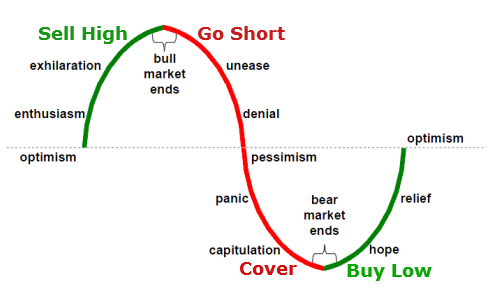
Explanation: Being a bear while everyone else is bullish is one of the most challenging propositions in investing. For instance, ‘Short selling is an incredibly lonely proposition,’ billionaire hedge fund manager Bill Ackman says. Yet, it can pay off big time if you get your TIMING right. However, since most people, even professional investors are terrified of shorting, I will introduce a quick series about short selling, proper risk management when short selling and the best way to maximize returns. This was to be a part of my never finished book (no time to finish it)…….
Buy Low, Sell High, Go Short & Cover Investment Strategy:
Rule #1: Buy Substantially Undervalued Securities (Minimizing Risks & Maximizing Returns).
This particular rule applies to both value and growth oriented investments. In particular, we are looking for the following stocks or situations.
- Stocks of companies that have declined in value 50-90% over the last few months or years. At the same time, the underlying business or industry conditions suggest that things are about to improve. In other words, recent fundamental developments might be mitigating whatever issues had caused the stock to decline so much in the first place.
- Stocks of companies that are growing at a fast pace (large or small), yet their market valuations are well below their intrinsic values. This situation typically occurs at bear market bottoms or after sudden market crashes/corrections.
- Stocks of companies that are turning their fortunes around with new popular products, restructuring, asset divestiture, new management, etc….. Yet, their positive efforts haven’t been recognized in the marketplace thus far.
By concentrating strictly on the above areas, we zero in on la crème de la crème available in the stock market at any given time. In fact, the selection criteria’s above are so stringent that investors should not be able to find that many stocks satisfying all of the requirements. Especially in aging bull markets and/or at market tops. For instance, as of July 2015 I am unable to find a single stock issue that would match up to any of the requirements above.
What do we get in return when we implement such stringent requirements?
We end up identifying individual stocks that have the highest probability of experiencing explosive multiyear and multi bagger growth in their share price. Just as was outlined in one of my earlier books The Hunt For 10 Baggers.
Rule #2: Sell & Go Short When Technical and Timing Indicators Confirm (Trading)
As mentioned earlier, one of the biggest mistakes investors make is they don’t know when to get out. The investment industry has done a fairly good job brainwashing people into believing that the best holding period is forever. So much so that nowadays everyone is trying to follow in Warren Buffett’s footsteps.
Unfortunately, the reality is quite different. Look at almost any stock chart and you will see even the most successful companies drop 50-90% at one time or another. For some it’s a regular occurrence. Making the “hold forever” investment premise not only obsolete, but truly foolish. That brings us to the next set of rules.
- Always be ready to liquidate your long positions and go short if technical indicators suggest that the stock price is about to break down. No matter how great the underlying fundamentals are at the time.
- Always be ready to liquidate your long positions and go short at bull market tops. No matter how resistant to such bear markets you believe your stocks or industries are.
- Always be ready to liquidate your long position and go short when the underlying stock price has experienced a massive run up and could now be considered in a highly speculative bubble. This rule applies to all market conditions. Bull and bear.
- Always keep detailed technical charts, long-term and short-term, for all of your stocks and the overall market. These charts will tell you when stock prices are about to break down.
- Liquidate your long positions and go short as soon as the daily, weekly or monthly trends change from bull to bear. Typically, the exact points of exit will be based on your overall trading strategy and risk profile.
- Go short at the same time and price.
Such strict rules allow us to accomplish a number of things. First, they force us to be vigilant as we continue to scan for possible market, industry or stock specific corrections. Minimizing our risk profile in the process. Second, the rules above force us to sell our long positions at the onset of corrections. Preventing unnecessary and at times massive losses. Finally, these rules give us the ability to profit on the downside should a significant move down develop fully.
To be continued……..
It’s Hard To Be A Bear When Everyone Is Bullish. Part 7 Google
